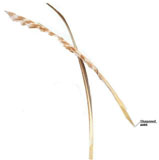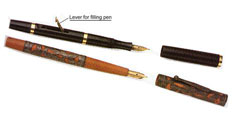

 Quills |
Quill pens were the standard writing implement from the 7th century until the 19th century except in the Far East, where the Chinese brushes were used. This was most likely because in the Far East, they were heavily influenced by the pictogram age while the rest of the world moved on to the alphabet. Pictograms look better and are somewhat easier to write with brushes as compared to, say, a hard quill. | |
| In the 1930s, things change slightly for the fountain pen. Dip pens were invented, in which people used a wooden stem, metal nib holder and changeable nibs. Early pen nibs were all steels although present day versions are tipped with hard wearing metals such as osmium or platinum. Of course, they didn't have access to all that back then, so they had to settle for steel that was prone to rust, bending and other "enviromental" damages. |
| It was only in 1884 that the first proper - nay, practical - fountain pen was invented by a certain Lewis Edson Waterman. He devised a pen that used capillary action to control ink flow. Although his fountain pen had to be filled with an eye-dropper, it became popular because the earlier versions of the fountain pen (appearing as early as 1800) was prone to clogging up at the tip region because the dye wasn't ground finely enough. Now although Waterman's pen was a great improvement, problems such as leaking and refilling remained, which remained largely unsolved until the early Twentieth century, where levers, ink cartridges and more advanced capillary action fountain pens were invented. |  20th Century Fountain Pens |